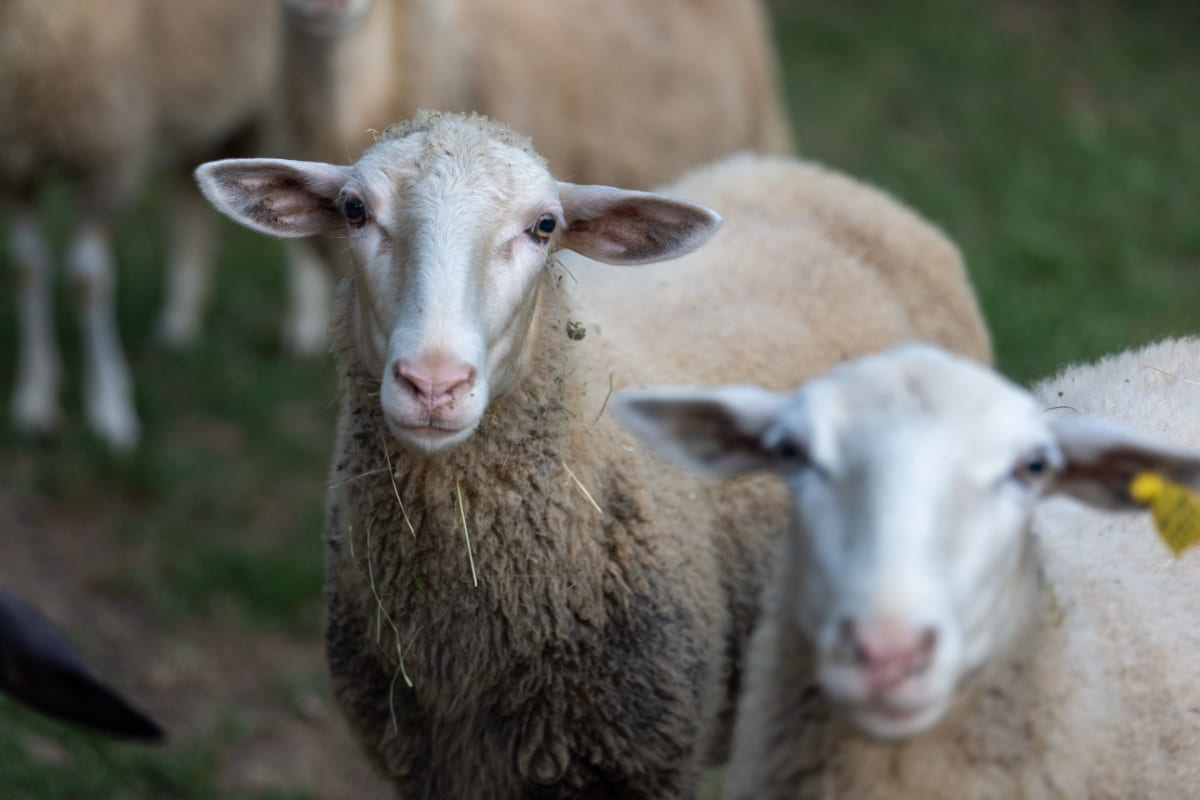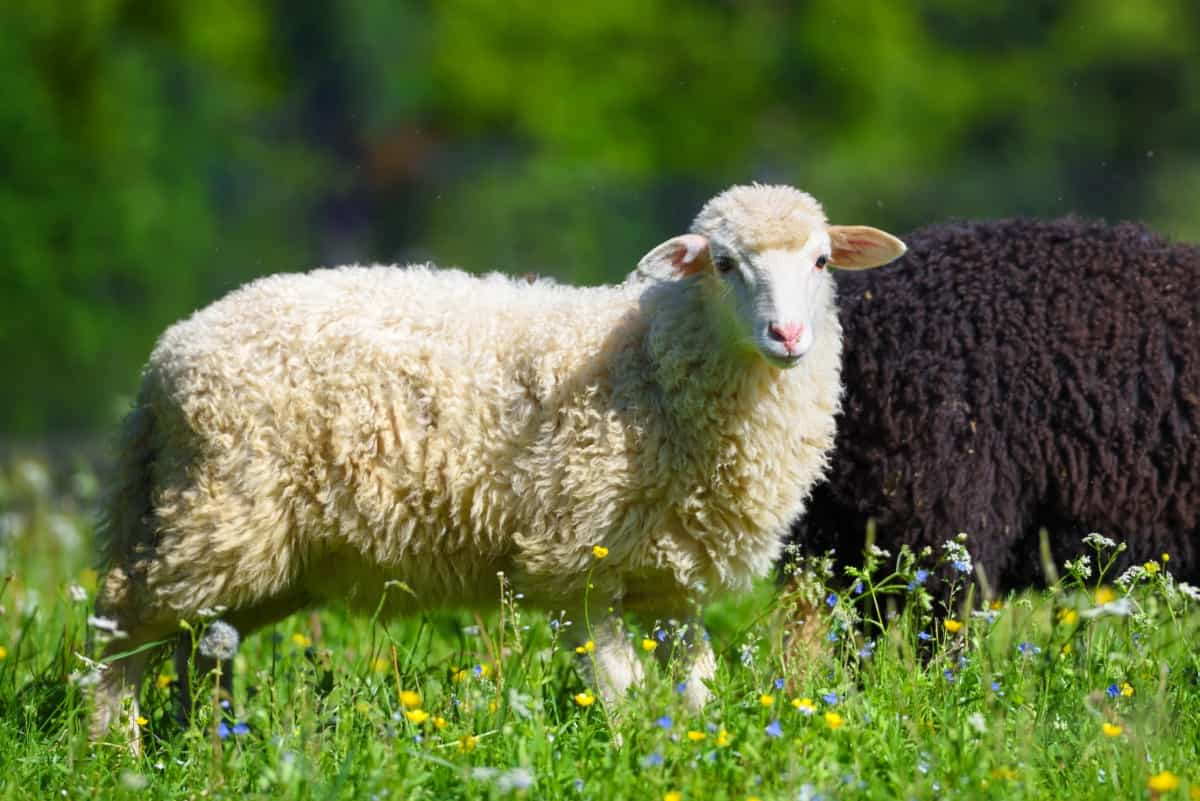Thanks to the breed’s hardiness and low maintenance, Katahdin sheep farming is becoming increasingly popular for those interested in sustainable sheep farming. Raising Katahdin sheep is appealing due to their adaptability, meat production quality, and notable parasite resistance, which sets them apart from other breeds. Katahdin sheep care is straightforward, making them an excellent choice for novice and experienced farmers.
With their wool-less coats, Katahdin sheep eliminate the need for shearing, further contributing to their reputation as a low-maintenance breed. The benefits of raising Katahdin sheep extend beyond ease of care to include efficient lambing management and a strong breed profile, promoting a sustainable approach to modern agriculture.

Raising Katahdin Sheep
History and Origin
Katahdin sheep originated in Maine, USA, and developed by crossing various breeds to create a hardy, wool-less sheep suited to meat production. Their name comes from Mount Katahdin, reflecting their robust nature and American heritage. This breed’s development focused on creating sheep that could thrive in diverse environmental conditions without intensive care.
Key Characteristics
Key characteristics of Katahdin sheep include their exceptional adaptability, resistance to common sheep parasites, and the absence of wool, which eliminates the need for shearing. These sheep typically live up to 10-12 years, showcasing their longevity and resilience in various farming setups. Their easy-going nature and efficient meat production make them a favoured choice among farmers looking for sustainable livestock options.
Katahdin Sheep Breed Profile
Physical Traits
Katahdin sheep display various colours and patterns, but they are especially known for their hair coat that sheds seasonally, negating the need for shearing. Adult Katahdins usually weigh between 120 to 250 pounds, with heights varying from 24 to 30 inches, making them a medium-sized breed well-suited for diverse farming environments. Their physical build is muscular, designed for efficient meat production.
Genetic Diversity
The genetic diversity within the Katahdin breed is relatively high due to its mixed origins, contributing to its adaptability and robustness. This diversity is crucial for maintaining the health and vitality of the population, allowing Katahdin sheep to thrive in various climates and conditions.
Advantages of Raising Katahdin Sheep
Low Maintenance Requirements
One of the most significant advantages of raising Katahdin sheep is their low maintenance requirements. Their hair coat, which sheds in warmer months, eliminates the need for shearing, reducing labour and equipment costs. Additionally, their adaptability to different climates and foraging efficiency make them ideal for sustainable farming practices.
Parasite Resistance
Katahdin sheep are known for their natural resistance to parasites, a trait that significantly reduces the need for chemical dewormers and contributes to overall flock health. This resistance is particularly beneficial in humid and warm climates with high parasite loads, making Katahdin sheep a smart choice for farmers looking to reduce chemical inputs in their farming practices.
Nutritional Management
Feeding Requirements
Feeding Katahdin sheep involves providing a balanced diet that meets their nutritional needs without excessive grain supplements. Their diet primarily consists of pasture grasses and hay, particularly during winter when fresh forage is unavailable. Proper nutrition is essential for maintaining Katahdin sheep’s health, productivity, and reproductive efficiency.
Pasture Management Tips
Effective pasture management is key to sustaining a healthy and productive Katahdin flock. Rotational grazing practices help maintain pasture quality and prevent overgrazing, ensuring a consistent supply of fresh forage. Managing pastureland also involves regular monitoring and reseeding as necessary to support the dietary needs of the sheep.
Health and Wellness
Common Health Concerns
Although Katahdin sheep are typically sturdy, they remain vulnerable to common health issues like foot rot, respiratory infections, and internal parasites, despite their inherent resilience. Regular health checks and maintaining clean, dry living conditions help prevent the onset and spread of these issues within the flock.
Preventative Care and Treatments
Preventative care for Katahdin sheep includes routine vaccinations, parasite management strategies tailored to their resistance levels, and regular veterinary check-ups to ensure early detection and treatment of potential health issues. A proactive stance on health and wellness is essential for ensuring the long-term vitality and productivity of Katahdin sheep.
In case you missed it: Zwartbles Sheep: Raising Facts, Profile, Characteristics, Uses, and Care

Breeding and Reproduction
Breeding Strategies
Effective Katahdin sheep breeding strategies focus on selecting individuals with strong genetic traits such as parasite resistance, maternal instincts, and growth rates. Utilising planned mating and keeping detailed records of lineage and performance help enhance the genetic quality of the flock over time, promoting the breed’s sustainability.
Lambing Management
Katahdin lambing management involves providing adequate care to pregnant ewes and ensuring a safe and clean environment for lambing. Monitoring ewes closely during the lambing season, assisting with births if necessary, and ensuring lambs receive proper nutrition and care in their early weeks are all critical components of successful lambing management.
Flock Management
Daily Care and Handling
Daily care and handling of Katahdin sheep involve regular checks to ensure the well-being of each flock member, provide fresh water, and ensure that feed is available and nutritious. Handling Katahdin sheep with patience and care is essential to maintain a calm and stress-free environment, which benefits their health and productivity. Observing the flock’s behaviour daily also helps detect any health issues or changes in the flock dynamics early.
Flock Structure and Social Dynamics
Understanding and managing the flock structure and social dynamics are crucial in Katahdin sheep farming. Katahdins are known for their strong flocking instinct, which can influence their grazing patterns, breeding, and overall well-being. A stable social hierarchy helps reduce stress and conflicts within the flock. Farmers should consider these dynamics when making management decisions, such as grouping by age or reproductive status, to promote harmony and reduce resource competition.
Wool and Meat Production
Market Opportunities for Katahdin Lamb
The market opportunities for Katahdin lamb are growing as demand for grass-fed, sustainably raised meat increases. Katahdin lambs are known for their lean, flavorful meat, which appeals to consumers looking for healthier meat options. Direct marketing to consumers, selling to local butchers, or participating in farmers’ markets can be effective strategies for reaching potential customers and capitalising on the market demand for Katahdin lamb.
Wool-Less Advantage
The wool-less advantage of Katahdin sheep is a significant benefit for farmers, as it eliminates the need for shearing, wool handling, and related expenses. This trait makes Katahdins particularly suited for meat production and reduces the labour and costs associated with wool sheep breeds. The absence of wool also means that Katahdins are more comfortable in warmer climates and have fewer issues with parasites that can hide in wool.
In case you missed it: Ultimate Guide to Raising Lonk Sheep: Facts, Profile, Characteristics, Uses, and Care

Housing and Shelter
Designing Shelter for Different Climates
Designing a shelter for Katahdin sheep involves considering the specific climate challenges of the area. In colder regions, shelters should protect from wind, rain, and snow while ensuring adequate ventilation to prevent moisture buildup. In warmer climates, shelters should offer ample shade and airflow to help keep the sheep cool. The design should be flexible to accommodate the changing needs of the flock throughout the year.
Seasonal Shelter Adjustments
Seasonal shelter adjustments are necessary to ensure the comfort and safety of Katahdin sheep throughout the year. During the winter, additional bedding may be needed to keep the sheep warm, and shelters may need to be fortified against harsh weather conditions. Ensuring that shelters provide enough shade and ventilation to prevent overheating is crucial in the summer. These adjustments help maintain the health and productivity of the flock in varying seasonal conditions.
In case you missed it: Ultimate Guide to Raising Herdwick Sheep: Facts, Profile, Characteristics, Uses, and Care

Conclusion
Raising Katahdin sheep offers a sustainable and efficient approach to farming, thanks to their low maintenance needs, natural parasite resistance, and wool-less coats. With careful flock management, nutritional oversight, and appropriate housing, farmers can maximize the health and productivity of their Katahdin sheep. These attributes and growing market opportunities for Katahdin lamb make this breed an attractive option for farmers aiming for profitable and environmentally friendly livestock farming.
Note: The images presented in this post are intended solely for representation purposes. The images are meant to serve as visual aids and should not be relied upon as accurate representations of their real-life counterparts.
- Feed Your Flock for Less: Top 10 Tips to Save on Chicken Feed
- Ultimate Guide to Ossabaw Island Hog: Breeding, Raising, Diet, and Care
- Hatching Answers: The Top 10 Reasons Your Chickens Aren’t Laying Eggs
- Eggs and Economics: Breaking Down the Cost of Raising Backyard Chickens
- Defend Your Greens: Proven Methods to Keep Iguanas Out of Your Garden
- Ultimate Guide to Cinnamon Queen Chicken: A Comprehensive Guide for Beginners
- Ultimate Guide to California Tan Chicken: Breeding, Raising, Diet, Egg-Production and Care
- Ultimate Guide to Marsh Daisy Chicken: Breeding, Raising, Diet, and Care
- 10 Types of Chicken Farming Businesses You Can Start for Profits